Vegetables That Are Pretty
Edibles can enhance your garden design as well as any ornamental can
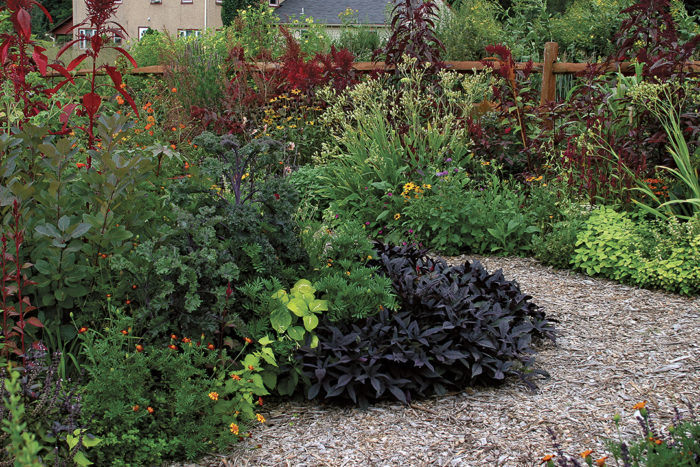
In the quest to find something new and different for your garden each spring, it’s easy to zoom right past the offerings of veggie seeds and transplants on your way to the glitzier displays of flower-filled annuals and perennials. Don’t be too quick, though, to dismiss vegetables as merely practical plants. If you consider them purely from a design standpoint—for their interesting form, their colorful leaves, their dramatic blooms, and their showy fruit—you’ll see that many vegetables easily rival more traditional ornamentals. And they have the advantage of being tasty as well as attractive.
There’s nothing new, of course, about blurring the line between edible and ornamental plantings. That’s a cornerstone of the traditional cottage garden style and of a potager. It’s a little different, though, to look first at vegetables for their decorative features, then make allowances for the possibility of picking them. The primary point here isn’t raising enough food to feed your family through the winter or making dramatic design statements with artfully patterned vegetable plantings. It’s the joy of creating exciting combinations and beautiful gardens with plants that you could pick if you have the time and desire to do so.
So what sets the best edibles apart from the rest? They’re undeniably ornamental even if you never harvest from them. They may have distinctive foliage that contributes color or texture over an extended period or even through the entire growing season. They may have striking flower forms that are guaranteed to grab interest from bud stage through seed formation. Or they may produce an abundance of long-lasting fruit that take on rich colors as they ripen. And the best edibles—the pick of the crop, as it were—combine two or more of these traits in one plant.
Edibles spice up the border
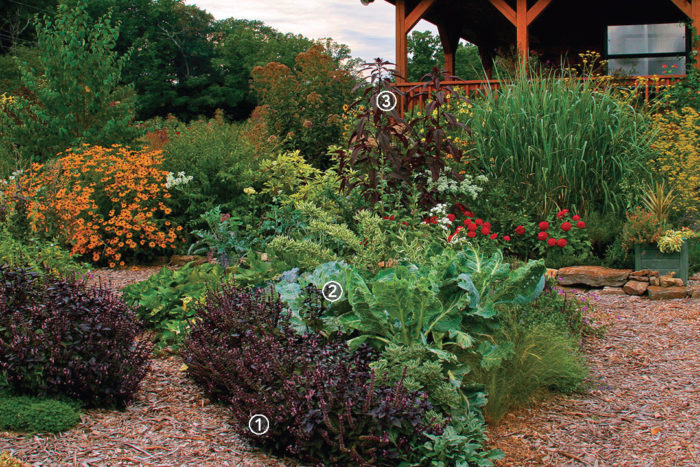
1. Front-of-the-border color
This purple basil provides a color punch that won’t quit.
2. Bold focal point
The eye-catching foliage comes not from an exotic ornamental but from Portuguese kale.
3. Back-of-the-border bang
This ‘Hopi Red Dye’ amaranth adds to the red/burgundy color theme of the area.
Add veggies for a bold statement
A number of plants from the family Brassicaceae (also known as Cruciferae) have long been prized for their edible parts—specifically, in the case of cabbage, kale, and Brussels sprouts, for their nutritious foliage. But even if you don’t relish the thought of eating them, these brassicas offer some absolutely stunning shapes and leaf textures, contributing height, mass, and color to ornamental combinations.
In sunny gardens, for instance, plants such as cabbage and its nonheading relative’s Portuguese kale (Brassica oleracea var. tronchuda, annual) and ‘Red Russian’ kale (Brassica napus pabularia ‘Red Russian’, annual) fill the role that hostas (Hosta spp. and cvs., USDA Hardiness Zones 3–9) perform so admirably in shade gardens: providing broad mounds of large leaves to counterbalance an abundance of tiny or lacy leaves and flowers. And the bold, rounded heads of maturing cabbage stop traffic in their own right, creating a dramatic accent that’s unlike anything you can get from a traditional ornamental.
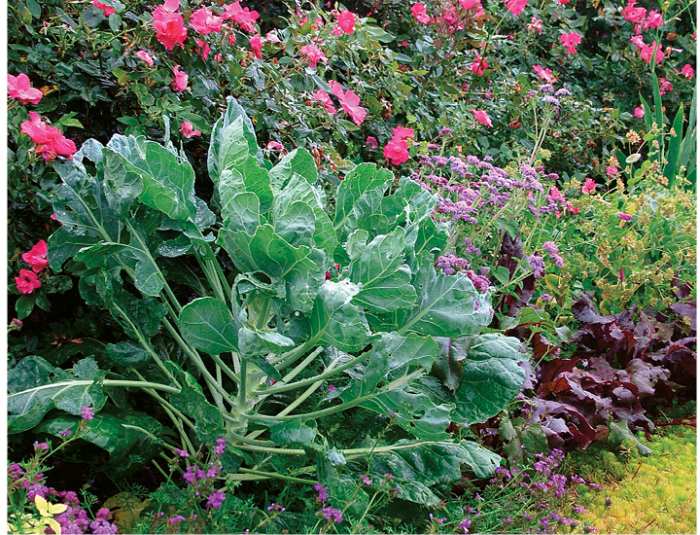
Kale is another brassica that doesn’t get much respect as a vegetable—let alone as an ornamental—but it’s invaluable for its height and form. The ultimate height varies by variety, but when you plant out seedlings in spring and let them grow through the whole season, some can easily reach 3 to 4 feet tall by fall. That allows you to plant them in the middle of the border, where their broad foliage clumps can rise through the seasons as their companions mature. Placing lower, bushy plants in front of the kale gives you the option of harvesting the lower kale leaves through the summer without leaving visible bare stems. Good choices for tall-growing kales are ‘Redbor’ and ‘Winterbor’.
Kales offer a range of leaf textures, as well. Many are strongly crinkled or frilly on the edges; others, such as Russian types (which mature at about 18 inches tall), have a flatter, jagged-edged foliage. ‘Nero di Toscana’ is great for foliage as well as height, with long, slender leaves that have a distinctive pebbly texture.
Brussels sprouts may elicit groans at the dinner table, but they’re more likely to inspire wows in the border. Starting out as loose, low heads of broad leaves, like cabbage, they also grow upward, like some types of kale, usually to about 30 inches by the end of the growing season. By late summer, the sprouts, which resemble miniature cabbages, form at the leaf joints along the stout main stem, adding even more interest. You can surround the plants with low companions to get the full effect of a leafy topknot above the knobby stem, or you could use bushier companions and just enjoy the leafy tops as mid border accents.
Cabbage-family crops grow quickly, so you get the full effect of their ornamental qualities in just one growing season. While they are technically biennials (producing flowers and seeds the following year), it’s best to treat them as annuals, harvesting the usable parts when you do fall cleanup or removing the plants in fall or early spring, then replanting.
If you’d prefer something big and bold without the bother of yearly replanting, then look beyond the cabbage family to some handsome perennial vegetables. In mild climates, artichokes (Cynara scolymus and cvs., Zones 8–9) are fantastic as foliage accents, with large, jagged-edged, gray-green to silvery leaves in dense clumps that can easily fill a space 3 to 4 feet across. The plants send up branching stems in summer, with gigantic buds that open into amazing thistlelike, electric blue flowers if you don’t pick them.
In cooler regions, consider rhubarb (Rheum rhabarbarum and cvs., Zones 3–9) instead. Give it a site with compost-enriched soil, and in a few years, you’ll enjoy a splendid show of broad, red-stemmed, bright green leaves in a clump 2 to 3 feet tall and 3 to 4 feet wide. Left alone, mature clumps send up 3-foot-tall stalks that carry plumes of white flowers in summer. Rhubarb might go dormant during the hottest part of summer unless you plan to mulch heavily and water regularly during dry spells. When temperatures moderate a bit and rainfall is more regular, the clumps will quickly produce fresh leaves and look great until frost. The edible part of rhubarb is its leaf stalks, not the leaves themselves. You can take generous harvests—mostly from early spring to early summer—from clumps that are at least a few years old without interfering with their ornamental value.
You can have color as well as taste
Form and texture aren’t the only contributions that vegetable plants make to the ornamental garden: They can provide outstanding color, as well.
Wonderful shapes and colors abound among the lettuces, from the bright chartreuse of ‘Australian Yellow’ and ‘Gold Rush’ to the red-speckled green of ‘Flashy Trout’s Back’ (also known as ‘Forellenschluss’) to the velvety deep red of ‘Merlot’ and ‘Outredgeous’. Beets, too, offer some outstanding dark-leaved varieties, such as ‘Bull’s Blood’ and ‘Macgregor’s Favorite’. Other ornamental-and-edible options include the ferny-leaved mustards—‘Golden Streaks’, with yellowish-green leaves, and ‘Ruby Streaks’, with purple leaves—and the broad-leaved bok choy variety ‘Violetta’, with glossy, near-black foliage. All of these make great annual alternatives to heucheras for foliage interest.
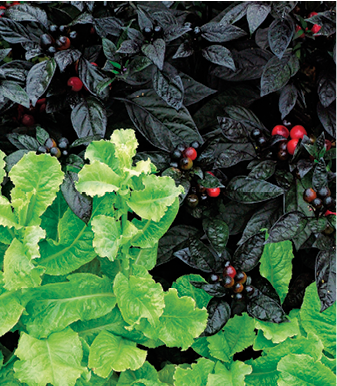
At the other end of the height, spectrum are tall edibles such as orach (Atriplex hortensis and cvs., annual), which can reach up to 6 feet tall. ‘Golden’ orach is greenish yellow; ‘Rubra’ orach has deep red stems, leaves, and seed heads. Another tall selection for intensely deep red stems, leaves, and seed plumes is ‘Hopi Red Dye’ amaranth (Amaranthus cruentus ‘Hopi Red Dye’, annual). Both the orachs and the amaranth can provide an ample supply of young leaves for salads without interfering with their border display.
Yet another must-have for luscious leaves is Swiss chard. It grows in 1- to 2-foot-tall, fountain-shaped clumps, with bright green or deep red leaves that have contrasting veins and stalks. You can find some single-color strains, such as ‘Rhubarb’ and ‘Charlotte’ in red; ‘Bright Yellow’ in yellow; and ‘Fordhook Giant’ with bright white stems and veins. But if you really want to make the most of the color range, buy a pack of ‘Bright Lights’ or ‘Five Color’ seeds or transplants and select some of each color that appears; a mix usually includes red, orange, yellow, pink, and white.
Showy fruit is the forte of many members of the family Solanaceae, including tomatoes and peppers. Small-fruited cherry tomatoes, as well as the even tinier-fruited current types, can climb through tuteurs or other decorative supports or scramble up through the stems of shrubby companions, festooning them with small yellow flowers and clusters of red, orange, or yellow rounded or pear-shaped fruit. Tomato plants themselves usually aren’t that interesting, but for something really different, seek out ‘Variegated’, with cream- to white-splashed leaves and medium-size red fruit.
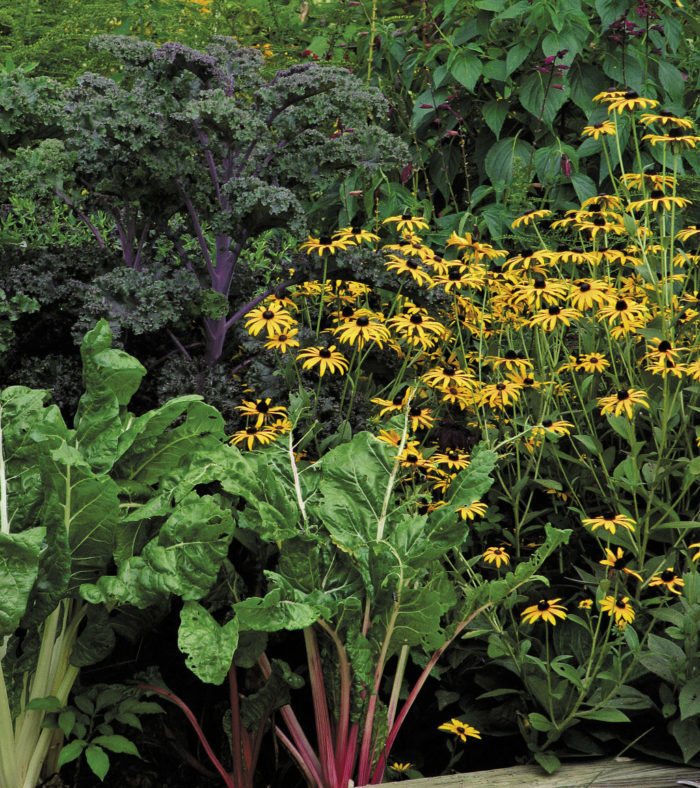
Peppers form low, bushy plants in the range of 1 to 3 feet tall. Their fruit is usually green or deep purple when they first form, ripening to bright shades of red, orange, yellow, or purple, and they range in size and shape from tiny round globes or tapering cones to substantial, blocky, bell-type peppers. Those with the most abundant, most colorful, and most easily visible fruit are the scorchingly hot types, such as the exquisite ‘Black Pearl’, which also offers deep purple foliage. You can also find, however, equally ornamental selections with easier-to-eat fruit, such as multicolored ‘Sweet Pickles’.
Why waste space on plants that are just pretty faces? If you start mixing in some that are both showy and productive, you’ll never be at a loss for a side dish or salad fixings. What a great excuse to spend your grocery money on the garden instead.
 Culture tip: Stay on top of foliage pests
Culture tip: Stay on top of foliage pests

One of the biggest problems for plants in the cabbage family are caterpillars, who chew large holes in the leaves. Many times the problem is minor, and you can deal with it by handpicking the pests or snipping off affected leaves; spraying with the biological control agent Bt (Bacillus thuringiensis var. kurstaki) greatly minimizes the damage. The holes that flea beetles create in the leaves of mustard, bok choy, and eggplant are tinier, but their damage is equally unattractive. They can be difficult to control, but sprays based on spinosad, neem, or capsaicin may help.
—Nancy J. Ondra, author of The Perennial Care Manual, tends her garden in Bucks County, Pennsylvania.
Photos, except where noted: Melissa Lucas
Fine Gardening Recommended Products

The Crevice Garden: How to make the perfect home for plants from rocky places
Fine Gardening receives a commission for items purchased through links on this site, including Amazon Associates and other affiliate advertising programs.

Gardener's Log Book from NYBG
Fine Gardening receives a commission for items purchased through links on this site, including Amazon Associates and other affiliate advertising programs.

A.M. Leonard Deluxe Soil Knife & Leather Sheath Combo
Fine Gardening receives a commission for items purchased through links on this site, including Amazon Associates and other affiliate advertising programs.







Comments
Log in or create an account to post a comment.
Sign up Log in